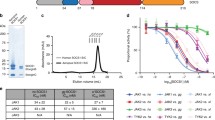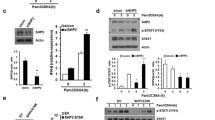Abstract
The Janus family tyrosine kinase—signal transducer and activator of transcription (Jak-STAT) signaling pathway is broadly used by interferons and type I cytokines. These cytokines and interferons activate Janus family tyrosine kinases (Jak kinases), which in turn phosphorylate and thereby activate STAT proteins. Before activation, STAT proteins are cytosolic proteins; after ssactivation, however, they are translocated to the nucleus where they function as transcription factors. This review summarizes salient features of the Jak-STAT pathway and focuses on the functional role of the different Jak kinases and STATs in vivo.
Similar content being viewed by others
References
Darnell JE Jr. STATs and gene regulation.Science. 1997;277:1630–1635.
Leonard WJ, O’Shea JJ. Jaks and STATs: biological implications.Annu Rev Immunol. 1998;16:293–322.
Leonard WJ. Type I cytokines and interferons and their receptors. In: Paul WE, ed.Fundamental Immunology. 4th ed. Philadelphia, PA: Lippincott Raven; 1999:741–774.
Witthuhn BA, Quelle FW, Silvennoinen O, et al. JAK2 associates with the erythropoietin receptor and is tyrosine phosphorylated and activated following stimulation with erythropoietin.Cell. 1993;74:227–236.
Argetsinger LS, Campbell GS, Yang X, et al. Identification of JAK2 as a growth hormone receptor-associated tyrosine kinase.Cell. 1993;74:237–244.
Please see multiple reviews of STAT proteins by multiple authors.Oncogene. 2000;19:2466–2656.
Bhattacharya S, Eckner R, Grossman S, et al. Cooperation of Stat2 and p300/CBP in signalling induced by interferon α.Nature. 1996;383:344–347.
Zhang JJ, Vinkemeier U, Gu W, Chakravarti D, Horvath CM, Darnell JE Jr. Two contact regions between Stat1 and CBP/p300 in interferon gamma signaling.Proc Natl Acad Sci U S A. 1996;93:15092–15096.
Deckeer T, Kovarik P. Serine phosphorylation of STATs.Oncogene. 2000;19:2628–2637.
Horvath CM, Darnell JE Jr. The state of the STATs: recent developments in the study of signal transduction to the nucleus.Curr Opin Cell Biol. 1997;9:233–239.
Lew DJ, Decker T, Strehlow I, Darnell JE Jr. Overlapping elements in the guanylate-binding protein gene promoter mediate transcriptional induction by alpha and gamma interferons.Mol Cell Biol. 1991;11:182–191.
Xu X, Sun Y-L, Hoey T. Cooperative DNA binding and sequenceselective recognition conferred by the STAT amino terminal domain.Science. 1996;273:794–797.
Vinkemeier U, Cohen SL, Moarefi I, Chait BT, Kuriyan J, Darnell JE Jr. DNA binding of in vitro activated Stat1a, Stat1b and truncated Stat1: interaction between NH2-terminal domains stabilizes binding of two dimers to tandem DNA sites.EMBO J. 1996;15:5616–5626.
Vinkemeier U, Moarefi I, Darnell JE Jr, Kuriyan J. Structure of the amino-terminal protein interaction domain of STAT-4.Science. 1998;279:1048–1052.
John S, Vinkemeier U, Soldaini E, Darnell JE Jr, Leonard WJ. The significance of tetramerization in promoter recruitment by Stat5.Mol Cell Biol. 1999;19:1910–1918.
Soldaini E, John S, Moro S, Bollenbacher J, Schindler U, Leonard WJ. DNA binding site selection of dimeric and tetrameric Stat5 proteins reveals a large repertoire of divergent tetrameric Stat5a binding sites.Mol Cell Biol. 2000;20:389–401.
Kim TK, Maniatis T. Regulation of interferon-gamma-activated STAT1 by the ubiquitin-proteasome pathway.Science. 1996;273:1717–1719.
Subtil A, Rocca A, Dautry-Varsat A. Molecular characterization of the signal responsible for the targeting of the interleukin 2 receptor beta chain toward intracellular degradation.J Biol Chem. 1998;273:29424–29429.
Yasukawa H, Sasaki A, Yoshimura A. Negative regulation of cytokine signaling pathways.Annu Rev Immunol. 2000;18:143–164.
Kovanen PE, Leonard WJ. Cytokine signaling: inhibitors keep cytokines in check.Curr Biol. 1999;9:R899-R902.
Shuai K. Modulation of STAT signaling by STAT-interacting proteins.Oncogene. 2000;19:2638–2644.
Rodig S, Meraz MA, White JM, et al. Disruption of the Jak1 gene demonstrates obligatory and nonreduntant roles of the Jaks in cytokine-induced biologic responses.Cell. 1998;93:373–383.
Parganas E, Wang D, Stravopodis D, et al. Jak2 is essential for signaling through a variety of cytokine receptors.Cell. 1998;93:385–395.
Neubauer H, Cumano A, Müller M, Wu H, Huffstadt U, Pfeffer K. Jak2 deficiency defines an essential developmental checkpoint in definitive hematopoiesis.Cell. 1998;93:397–409.
Noguchi M, Yi H, Rosenblatt HM, et al. Interleukin-2 receptor γ chain mutation results in X-linked severe combined immunodeficiency in humans.Cell. 1993;73:147–157.
Macchi P, Villa A, Gillani S, et al. Mutations of Jak-3 gene in patients with autosomal severe combined immune deficiency (SCID).Nature. 1995;377:65–68.
Russell SM, Tayebi N, Nakajima H, et al. Mutation of Jak3 in a patient with SCID: Essential role of Jak3 in lymphoid development.Science. 1995;270:797–800.
Puel A, Ziegler SF, Buckley RH, Leonard WJ. Defective IL7R expression in T-B+NK+ severe combined immunodeficiency.Nat Genetics. 1998;20:394–397.
Shimoda K, Kato K, Aoki K, et al. Tyk2 plays a restricted role in IFNα signaling, although it is required for IL-12-mediated T cell function.Immunity. 2000;113:561–571.
Karaghiosoff M, Neubauer H, Lassnig C, et al. Partial impairment of cytokine responses in Tyk2-deficient mice.Immunity. 2000;13:549–560.
Meraz MA, White JM, Sheehan KC, et al. Targeted disruption of the Stat1 gene in mice reveals unexpected physiologic specificity in the JAK-STAT signaling pathway.Cell. 1996;84:431–442.
Durbin JE, Hackenmiller R, Simon MC, Levy DE. Targeted disruption of the mouse Stat1 gene results in compromised innate immunity to viral disease.Cell. 1996;84:443–450.
Park C, Li S, Cha E, Schindler C. Immune response in Stat2 knockout mice.Immunity. 2000;13:795–804.
Akira S. Roles of STAT3 define by tissue-specific gene targeting.Oncogene. 2000;19:2607–2611.
Kaplan MH, Sun YL, Hoey T, Grusby MJ. Impaired IL-12 responses and enhanced development of Th2 cells in Stat4- deficient mice.Nature. 1996;382:174–177.
Thierfelder WE, van Deursen JM, Yamamoto K, et al. Requirement for Stat4 in interleukin-12-mediated responses of natural killer and T cells.Nature. 1996;382:171–174.
Lin J-X, Mietz, J, Modi WS, John S, Leonard WJ. Cloning of human Stat5B. Reconstitution of interleukin-2-induced Stat5A and Stat5B DNA binding activity in COS-7 cells.J Biol. Chem. 1996;271:10738–10744.
Liu X, Robinson GW, Gouilleux F, Groner B, Hennighausen L. Cloning and expression of Stat5 and an additional homologue (Stat5b) involved in prolactin signal transduction in mouse mammary tissue.Proc Natl Acad Sci U S A. 1995;92:8831–8835.
Udy GB, Towers RP, Snell RG, et al. Requirement of STAT5b for sexual dimorphism of body growth rates and liver gene expression.Proc Natl Acad Sci U S A. 1997;94:7239–7244.
Nakajima H, Liu XW, Wynshaw-Boris A, et al. An indirect effect of Stat5a in IL-2-induced proliferation: a critical role for Stat5a in IL-2-mediated IL-2 receptor α chain induction.Immunity. 1997;7:691–701.
Imada K, Bloom ET, Nakajima H, et al. Stat5b is essential for natural killer cell-mediated proliferation and cytolytic activity.J Exp Med. 1998;188:2067–2074.
Moriggl R, Topham DJ, Teglund S, et al. Stat5 is required for IL-2-induced cell cycle progression of peripheral T cells.Immunity. 1999;10:249–259.
Kagami S-I, Nakajima H, Kumano K, et al. Both Stat5a and Stat5b are required for antigen-induced eosinophil and T-cell recruitment into the tissue.Blood. 1999;95:1370–1377.
Kaplan MH, Schindler U, Smiley ST, Grusby MJ. Stat6 is required for mediating responses to IL-4 and for development of Th2 cells.Immunity. 1996;4:313–319.
Shimoda K, van Deursen J, Sangster MY, et al. Lack of IL-4-induced Th2 response and IgE class switching in mice with disrupted Stat6 gene.Nature. 1996;380:630–633.
Migone T-S, Lin J-X, Cereseto A, et al. Constitutively activated Jak- STAT pathway in T cells transformed with HTLV-I.Science 1995;269:79–81.
Takemoto S, Mulloy JC, Cereseto A, et al. Proliferation of adult T cell leukemia/lymphoma cells is associated with the constitutive activation of JAK/STAT proteins.Proc Natl Acad Sci U S A. 1997;94:13897–13902.
Weber-Nordt RM, Egen C, Wehinger J, et al. Constitutive activation of STAT proteins in primary lymphoid and myeloid leukemia cells and in Epstein-Barr virus (EBV)-related lymphoma cell lines.Blood. 1996;88:809–816.
Danial NN, Pernis A, Rothman PB. Jak-STAT signaling induced by the v-abl oncogene.Science. 1995;269:1875–1877.
Yu CL, Meyer DJ, Campbell GS, et al. Enhanced DNA-binding activity of a Stat3-related protein in cells transformed by the Src oncoprotein.Science. 1995;269:81–83.
Bowman T, Garcia R, Turkson J, Jove R. STATs in oncogenesis.Oncogene. 2000;19:2474–2488.
Author information
Authors and Affiliations
About this article
Cite this article
Leonard, W.J. Role of Jak Kinases and STATs in Cytokine Signal Transduction. Int J Hematol 73, 271–277 (2001). https://doi.org/10.1007/BF02981951
Received:
Accepted:
Published:
Issue Date:
DOI: https://doi.org/10.1007/BF02981951




